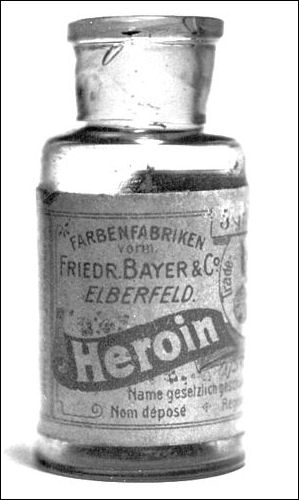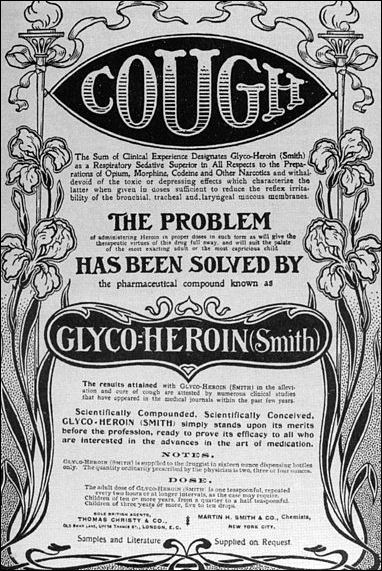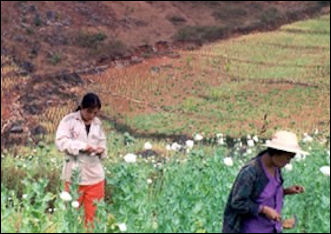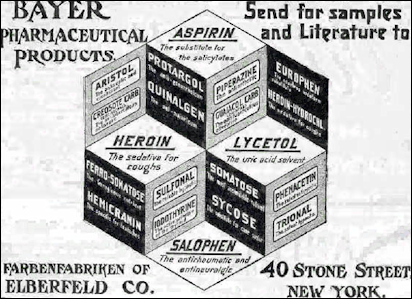INVENTION OF MORPHINE

Bayer heroin bottle Morphine, heroin and cocaine were all invented or brought to the market by German chemists. Morphine was first derived from opium poppies by a 20-year-old pharmacist assistant name Friedrich Sertuerner of Paderborn, Germany in 1803. He named the drug “morphium “ after Morpheus, the Greek god of dreams, and ran experiments on himself, describing the curative, euphoric and "terrible" aspects of the drug.
Sertuerner discovered the active ingredient of opium by dissolving it in acid then neutralizing it with ammonia, producing the alkaloid — Principium somniferum, or morphine. He received prizes, cash and international recognition for his discovery but morphine did not become widely used until the invention of the hypodermic needle . Morphine is believed to have been the first alkaloid to be isolated from a plant, The discovery set off a flurry of research into plant alkaloids which in turn led to the isolation of atrophine, caffeine, cocaine, quinine and other important drugs. Within half a century all these were made into medicines prescribed with precisely measured dosages for the first time.
E. Merck & Company of Darmstadt, Germany began commercially manufacturing morphine In 1827. With morphine, physicians believed that opium's bad qualities had been eliminated. Morphine is lauded as "God's own medicine" for its reliablity, long-lasting effects and safety. In the 19th century morphine was legal and easy to get a hold of in United States and Europe. Women with keep wayward husbands were advised to mix the drug into their coffee as a way to keep them at home. The power, potency and problems of morphine, and later heroin, was dramatically increased with introduction of the hypodermic needle. In 1843 Dr. Alexander Wood of Edinburgh pioneered the technique of administering morphine with an injection from a syringe, discovering the effects of morphine on his patients is instantaneous and three times more potent.
Morphine and opium were used before anesthesia was invented to relieve the pain of surgery. Wounded soldiers were given morphine poured onto gloves, which they licked periodically to relieve their pain. U.S. army medical kits still contain morphine, which is considered so important it remains part of the U.S. Strategic and Critical Materials Stockpile.
See Separate Article OPIODS: TYPES, EFFECTS AND DANGERS factsanddetails.com HISTORY AND USE OF OPIUM factsanddetails.com ; HEROIN USE factsanddetails.com ; OPIUM CULTIVATION AND HEROIN PRODUCTION factsanddetails.com ; GLOBAL HEROIN TRAFFICKING factsanddetails.com
Invention of Heroin
By the late 19th century, the habit-forming properties of opium and morphine were well known. In an effort to eliminate the addictiveness of these drugs pharmacists began tinkering with their s molecular structure. Heroin was developed in 1874 by a London pharmacist, C.R. Wright, searching for a non-addictive form of morphine. He boiled morphine with acetic anhydride and produced a drug more soluble in fat — which enables it reach the brain quicker — and had painkilling properties about 2½ times stronger than morphine. This drug was diacetylmorphine, better known as heroin.
In 1895, Heinrich Dreser, an employees at the Bayer Company of Elberfeld, Germany, finds that diluting morphine with acetyls produces a drug without the common morphine side effects. Bayer begins production of diacetylmorphine and coins the name "heroin." In 1898, Bayer introduced heroin as a medicine 11 days after aspirin was invented, It was initially marketed as a cough and diarrhea remedy and less-addicting and less toxic substitute for morphine. It was called "highly effective against coughs” and was claimed to be "a safe preparation free from addiction-forming properties." It was named "heroin" because of its heroic qualities.
Heroin turned out to be two to three times more potent than morphine. It was an already-metabolized version of morphine, so heroin had a more direct route to the brain than morphine itself. In the early 1900s, the philanthropic Saint James Society in the U.S. launched a campaign to supply free samples of heroin through the mail to morphine addicts who are trying give up their habits. In 1902, in various medical journals, physicians began discussing the side effects of using heroin as a morphine step-down cure, and reporting that the withdrawal symptoms from heroin equal to morphine addiction if not worse. In 1903, heroin addiction began rising to alarming rates.By the late 1920s heroin was the most widely abused opiate. [Source PBS Frontline]
In the early 1900s, several physicians experiment with new treatments for heroin addiction. The popular cure of Dr. Alexander Lambert and Charles B. Towns touted as the most "advanced, effective and compassionate cure" for heroin addiction cure consisted of a seven-day regimen, which included a five day purge of heroin from the addict's system. As a substitute the addicts were given doses of the deadly nightshade, a poisonous plants that produces belladonna delirium, a delusional state accompanied by numbness, giddiness, confusion, and hallucinations.
Laws Controlling Opium, Morphine and Heroin

Opiates were widely used legally in Europe and the United States well into the 20th century. By 1906, more than 50,000 medicines containing opium had been patented. Housewives and businessmen were enthusiastic users of opium-based elixirs. Dorothy’s experience in “The Wizard of Oz” was triggered by opium. Remember the field of poppies.
Legislation to restrict narcotics like heroin, morphine and cocaine was not enacted in the United States and other countries until the early 20th century. The earliest law-enforcement legislation on narcotics in the U.S. was a tax imposed on opium and morphine in 1890 by the U.S. Congress. In 1905, the U.S. banned opium. In 1906, he Pure Food and Drug Act, regulating the labeling of products containing alcohol, opiates, cocaine, and cannabis, among others, was passed in the U.S. The law went into effect in 1907 . The Pure Food and Drug Act required contents labeling on patent medicines by pharmaceutical companies. The availability of opiates and the number opiate consumers sharply declines after that. In 1909, on the eve of the Shanghai Conference, in which the U.S. pressed for legislation aimed at suppressing the sale of opium to China, the first federal drug prohibition law is passed in the U.S. It outlaws the importation of opium.
The International Opium Commission, which first met in Shanghai in 1909, established a worldwide treaty, eventually signed by 116 nations, that declared some opium must remain available because "the medical use of narcotic drugs continues to be indispensable for the relief of pain and suffering" but measures should be taken to curb illegal production because "addiction to narcotic drugs constitutes a serious evil...a social and economic danger to mankind." The U.S. delegation at The International Opium Commission in Shanghai was headed by are Dr. Hamilton Wright and Episcopal Bishop Henry Brent, both of whom focused on the immoral and evil effects of opium.
In 1912, a U.S. government publication reported 5,000 fatal poisonings in one year, mostly related to opium and cocaine. In December 1914, the Harrison Narcotics Tax Act was passed, regulating and imposing a tax upon the sale of opium, heroin and cocaine for the first time. The Act took effect March 1915. The Harrison Narcotics Act was aimed primarily at tackling cocaine abuse but also addressed heroin abuse and addiction. It required doctors, pharmacists and others who prescribed narcotics to register and pay a tax.
In 1923, the U.S. Treasury Department's Narcotics Division (the first federal drug agency) banned all legal narcotics sales. With the prohibition of legal venues to purchase heroin, addicts are forced to buy from illegal street dealers. In the 1920s, in the wake of of the first federal ban on opium, a thriving black market opens up in New York's Chinatown. The 1942 Opium Poppy Control Act prohibited the possession or growing of the opium poppy without a license.
Development of the Illegal Heroin Market
Laws controlling opium imposed around the time of World War I encouraged dealers to process opium into morphine and heroin because they were easier to hide and smuggle and led to the development of the illegal heroin trade. Before World War II most heroin was produced in laboratories in Shanghai and Tianjin China and production and distribution there was largely overseen by Chinese triads. World War II and the Communist takeover of China ended heroin production in China.
After World War II the Mafia took advantage of a weak government in Italy and deal struck between Mafia leader Lucky Luciano and American military intelligence to set up heroin labs in Sicily. At this time much of the world’s opium was being supplied by Iran and to a lesser extent Turkey. United States support of the Shah government in Iran in the 1970s and deals made between the Nixon government and Turkey sharply reduced the amount of opium coming out of Iran and Turkey.
Opium and Heroin in the Golden Triangle of Southeast Asia

opium harvesting in the Golden Triangle In 1852, the British arrived in lower Burma, importing large quantities of opium from India and selling it through a government-controlled opium monopoly. Not long after that opium production increased in the highlands of Southeast Asia. Some of it made its way to China
In 1878, Britain passed the Opium Act with hopes of reducing opium consumption. Under the new regulation, the selling of opium was restricted to registered Chinese opium smokers and Indian opium eaters while the Burmese were strictly prohibited from smoking opium.
In 1886, the British acquired Burma's northeast region, the Shan state. Production and smuggling of opium along the lower region of Burma thrived despite British efforts to maintain a strict monopoly on the opium trade. Efforts by the British and French to control opium production in Southeast Asia were ultimately successful. Nevertheless, the opium trade in the Southeast Asian region, today referred to as the 'Golden Triangle', developed over time and began being major player in the profitable opium business during the 1940s.
In the 1930s, the majority of illegal heroin smuggled into the U.S. came from China and was refined in Shanghai and Tietsin. During World War II, opium trade routes were blocked and the flow of opium from India and Persia is cut off. Fearful of losing their opium monopoly, the French encouraged Hmong farmers to expand their opium production. After Burma gained independence from Britain at the end of World War II. Opium cultivation and trade flourishes in the Shan states in the late 1940s. The trade thrived even after Burma outlawed opium in 1962.
GOLDEN TRIANGLE: OPIUM, HEROIN, KUOMINTANG, HILL TRIBES AND THE CIA factsanddetails.com
Turkey, the French Connection and Mexican Mud
In the 1950s and 60s, Corsican gangsters dominate the U.S. heroin market through their connection with Mafia drug distributors. After refining the raw Turkish opium in Marseille laboratories, the heroin is made easily available for purchase by junkies on New York City streets. Some of the opium produced in Southeast Asia during the Vietnam War was transported to Marseille by the Corsican gangsters to be refined into heroin and shipped to the U.S via the French connection.
The source of the opium for most of the heroin that reached the United States in the 1960s was Turkey. The famous French Connection made Turkish opium into heroin at labs in Marseilles and then shipped the product to New York. In 1972 illegal opium production stopped just like that when U.S. president Richard Nixon told Turkish government officials in no uncertain terms that they had better clamp down on illegal opium smuggling if they wanted to keep receiving military aid. Most of Turkey's opium today is grown north of Antalya around Afyon and sold to European drug pharmaceutical companies.
When Southeast Asian and Turkish sources dried up in the mid 1970s after the end of the Vietnam War, the slack was taken by up raw opium from Mexico's Sierra Madre. "Mexican Mud" heroin temporarily replaced "China White" as the most common form of heroin in the U.S. until 1978. In 1978, the U.S. and Mexican governments launched a campaign to eliminate the source of raw opium in Mexico by spraying poppy fields with Agent Orange. The effort was deemed a success after the amount of "Mexican Mud" in the U.S. drug market declined.
In the 1990s, Colombia's drug lords, mainly known as cocaine suppliers, began introducing a high-grade form of heroin into the United States. At that time International drug trafficking organizations, including ones bases in China, Nigeria, Colombia and Mexico, were said to be "aggressively marketing heroin in the United States and Europe." .
Heroin Trade in the Vietnam War Era

Bayer Heroin in 1911
The Vietnam War was a boon for the opium and heroin business. Americans in Southeast Asia not only provided a fairly well paid source of buyers (soldiers) they also improved the infrastructure in Southeast Asia and provided ways for Asian drug producers to export their products around the world. In the early 1970s, laboratories opened in the Golden Triangle produced high-grade China White heroin. As time went on demand increased and to meet demand production increased as more drugs flooded the market more people had access to drugs.
In the 1950s, according to PBS, U.S. efforts to contain the spread of Communism in Asia involved forging alliances with tribes and warlords inhabiting the areas of the Golden Triangle, (an expanse covering Laos, Thailand and Burma), thus providing accessibility and protection along the southeast border of China. In order to maintain their relationship with the warlords while continuing to fund the struggle against communism, the U.S. and France supplied the drug warlords and their armies with ammunition, arms and air transport for the production and sale of opium. The result was an explosion in the availability and illegal flow of heroin into the United States and into the hands of drug dealers and addicts.
U.S. involvement in the Vietnam War in the 1960s and early 1970s was blamed for the surge in illegal heroin being smuggled into the States. To aid U.S. allies, the Central Intelligence Agency (CIA) sets up a charter airline, Air America, to transport raw opium from Burma and Laos.As well, some of the opium would be transported to Marseille by Corsican gangsters to be refined into heroin and shipped to the U.S via the French connection. The number of heroin addicts in the U.S. reaches an estimated 750,000. In the mid-1970s after Saigon fell, ending the Vietnam War, the heroin epidemic subsided
Khun Sa Era in the Golden Triangle
The warlord Khun Sa dominated the Golden Triangle opium and heroin supply and trade in the 1970s, 80s and 90s. In the early 1970s, as the Vietnam War was winding down and coming to an end, heroin exportation from parts of Southeast Asia controlled by Khun Sa, increased and the Golden Triangle became a major source for raw opium in the profitable "China White" drug trade, which picked up momentum in the late 1970s.
In the 1980s, Khun Sa became a heroin supplier as opium production in Burma increased under the rule of the State Law and Order Restoration Council (SLORC), the Burmese junta regime. The single largest heroin seizure at that time was made in Bangkok a — a 1,000-kilogram shipment of heroin en route to New York City that the U.S. believed originated from the Golden Triangle.
In 1990, a U.S. Court indicted Khun Sa on heroin trafficking charges for importing 1,600 kilograms of heroin into New York City over the course of eighteen months, as well as holding him responsible for the source of the heroin seized in Bangkok. In 1993 the Thai army with support from the U.S. Drug Enforcement Agency (DEA) launched a campaign in which thousands of acres of opium poppies in the Golden Triangle were destroyed.
In the mid 1990s, the Golden Triangle region was the world’s leading producer of opium, producing 2,500 tons annually. According to U.S. drug experts, opium and heroin were smuggled out of Burma on drug trafficking routes mainly through Laos, to southern China, Cambodia and Vietnam.
In January 1996, Khun Sa "surrendered" to SLORC. The U.S. didn’t believe it and thought it was just a deal in which Khun Sa agreed to end his 30-year-old revolutionary war against the government in exchange for retaining control of his opium trade.
KHUN SA factsanddetails.com
U.S. Drug Policy and Celebrity Heroin Deaths
In 1973, President Nixon created the DEA (Drug Enforcement Administration) under the Justice Dept. to consolidate virtually all federal powers of drug enforcement in a single agency. In the 1970s the U.S. State Department official initiated crop substitution programs for Third World growers of marijuana, coca or opium poppies. In 1984 many such programs were ended after it was determined the tactic could not work without eradication of the plants and criminal enforcement. Poor results were reported from eradicationprograms in Burma, Pakistan, Mexico and Peru.
In the 1990s, after efforts to eradicate opium at its source remained unsuccessful, the Clinton Administration orders a shift in policy away from the anti- drug campaigns of previous administrations. Instead the focus was placed on "institution building" with the hope that by "strengthening democratic governments abroad, [it] will foster law-abiding behavior and promote legitimate economic opportunity."
In October 1970 Janis Joplin, was found dead at Hollywood's Landmark Hotel, a victim of an "accidental heroin overdose." In 1982, the comedian John Belushi died of a heroin-cocaine — "speedball" overdose. In October 1993, 23-year-old actor River Phoenix also died from a "speedball" overdose. In April 1994, Kurt Cobain, of the rock band, Nirvana, died of heroin-related suicide.
Emergence of the Opium Trade in Afghanistan and the Golden Crescent
As Turkey and Mexico dried up as opium suppliers in the 1970s the slack was taken up by Afghanistan, Iran and Pakistan — in an area called the Golden Crescent. After the Shah was overthrown in Iran in 1979, the climate for opium and heroin production improved. War in Afghanistan in the 1980s and 90s created conditions that favored opium cultivation and heroin production. For a while so much opium and heroin was produced that the number of users increased in part because prices were so low.
The Golden Crescentwas the largest opium growing area in the world but now production is almost exclusively in Afghanistan. Before the Iran Revolution in 1979, much of the heroin produced from opium cultivated in the Golden Crescent was processed in laboratories in Iran. After the hard line Islamist regime came to power in Iran, it cracked down on heroin and opium production but there are
In the 1990s, Pakistan's production was estimated to be 300 or 400 metric tons a years. At that time most of Pakistan's opium and heroin ended up abroad but by the late 1990s the addiction rate within Pakistan began shooting up. At that time one government narcotics official described the situation as very serious, more so in the countryside than the cities. "In northern Pakistan," he said, "now you can find whole villages on hashish or opium." After that opium production was greatly reduced in Pakistan.
Much of the Golden Crescent's opium has been raised on land controlled by the Pashtuns, an ethnic that dominates large parts of Pakistan and Afghanistan. For the most part border doesn't exist in Pashtun territory in Pakistan and Afghanistan. A lot of the opium and heroin produced in Afghanistan is made by Pashtuns on Pashtun land and these Pashtuns have contacts with Pashtuns in Pakistan.
Opium production in Afghanistan exploded after the Soviets left in 1989. To some degree opium that was in Pakistan began shifting to Pakistan at that time. As part of their effort to combat Communism, the C.I.A. helped devolve the opium trade in Afghanistan as part of their campaign against Russia. The Taliban, which came to power in Afghanistan in 1996, both abetted and cracked down on opium cultivation but overall opium production was relatively low during their years in power as it was after the American invasion in 2002. After 2002, opium production — and heroin production — in Afghanistan steadily increased as the Taliban reasserted itself and needed sources of revenues to support areas it controlled and supply its militancy.
Image Sources: 1) DEA (Drug Enforcement Administration); 2) Normal Museum; 3) Wikimedia Commons
Text Sources: 1) “Buzzed, the Straight Facts About the Most Used and Abused Drugs from Alcohol to Ecstasy” by Cynthia Kuhn, Ph.D., Scott Swartzwelder Ph.D., Wilkie Wilson Ph.D., Duke University Medical Center (W.W. Norton, New York, 2003); 2) National Institute on Drug Abuse, National Institutes of Health, U.S. Department of Health and Human Services; 3) United Nations Office on Drugs and Crime (UNODC) and 4) National Geographic, New York Times, Washington Post, Los Angeles Times, Wikipedia, The Independent, Times of London, The New Yorker, Time, Newsweek, Reuters, Associated Press, AFP, , Lonely Planet Guides, and various books and other publications.
Last updated April 2022
